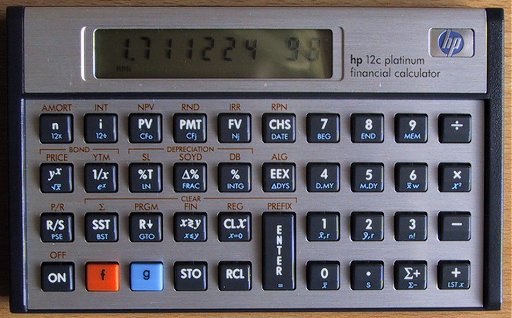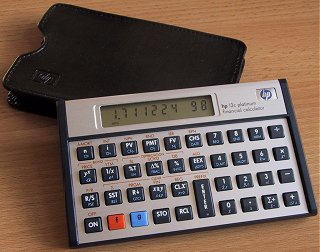hp 12c platinum
| here is a brand new 12c platinum, the remake
of the original 12c. the idea is to capture the
reputation of the original as a rock solid financial tool in an updated
and modernised version. does it succeed?
the first impression of the machine is fairly positive, the visual style is attractive and it comes with a nicely designed slip cover and comprehensive manual in book form rather than on cd. the 10 digit segmented display attempts to copy the original 12c, but is not quite as clear and the buttons have a hollow click feel whilst the case feel overall lighter and less solid. nevertheless, the buttons work adequately for their purpose. altogether the physical build is not as bad as it could be bearing mind everything today is made as cheap as possible overseas. indeed, later models of the original 12c were cost reduced and made in china and i am comparing this 12cp with an early 12c manufacture. |
 |
what about calculations
new to the 12cp is the ability to operate by algebraic entry (alg) as well as in rpn. the alg/rpn option is common to hp financial models and was also available on the hp17bii. the hp10b however was alg only whilst the original 12c was rpn only. the ability to choose is clearly the best of both worlds. the only noteworthy point of alg entry is that there is no operator precedence. so, for example, 2+3*5= calculates as (2+3)*5 = 25.
feature coverage
the 12cp covers the following general features: percentages, calendar date arithmetic, simple interest, compound interest, nominal and effective rate conversion, time value of money (tvm) with amortization and optional odd-periods. discounted cash flow analysis (npv and irr), bond price and yield (30/360 as well as actual), depreciation, 2d stats with linear regression, logs and usual calculator operations.
the unit is also programmable with 308 lines (steps) by default, which can be increased or decreased by partitioning memories. note: early versions of the 12cp have a bug preventing more than 253 steps being used properly.
for more information about the feature set, the 12cp manual can be downloaded from hp in pdf format.
lets try a tvm example
run of the mill tvm calculations should be just fine. lets try some slightly more tricky cases and see what we get.
an accountant is paid $0.01 per second every day and night for a year. the money is deposited directly into her bank account which pays 10% interest pa compounded every second. what is the correct bank balance after one year?
for this, we have, PV=0, PMT= -0.01, n = 365*24*60*60 and i = 10%/n. enter these as
| 365 ent, 24 * 60 * 60 * | N (enters number of periods) |
| 10 ent RCL N / | i (enters period interest) |
| 0 PV | 0 (no present value) |
| 0.01 chs | PMT (1 penny) |
| FV | 331,667.0067 |
which is agrees with the 12c and is the correct answer (unlike the 10b). however, the opposite problem of determining i (the interest rate) from the other variables gives the 12cp a hard time. after performing the above calculation. enter, 0 i, to clear i, then press i again. this will attempt to solve for i (which we know) from the other variables and the newly computed value of FV.
unfortunately, the machine goes off "running" for 4 and 1/2 minutes (which is far too long). it appears in trouble converging to a solution, but has no internal mechanism to improve this. the original 12c, however, copes with this case easily and readily returns the correct answer. at least the eventual result from the 12cp is the correct one.
lets try another
| FV = 1,000,000 PV = -999,999 PMT = 0 n = 32 |
and solve for i. this is a degenerate case with pmt = 0. correct answer to 10 figures is: 3.125001611e-6% |
for the 12c,
it goes as follows;
f FIN
32 n
999999 chs PV
1000000 FV
i (running) 3.125004736e-6%
whilst the 12cp gives 3.125001600e-6% which is more accurate than the 12c. well done.
unrealistic example
as a final tvm test for solving i, consider the unrealistic example of n=360, PMT= -10, PV = 100 and FV= 0 to solve for i. this is unrealistic because as you can see, a rate of i = 10% would never reach fv=0 and a value somewhat less than 10% would reach fv=0 in much less time than n=360. so we know that the value for i here is very close to 10% but not quite.
the actual answer is, i = 9.9999999999999874503000321496% which can only be shown in 10 digits as 10% exactly which can be seen to be the wrong answer. so what is a calculator to do?
the 12c gives 10% as the solution, which is correct insofar as it can display. this is interesting because it wont have converged to this result iteratively, but instead bailed out as best it can.
the 12cp, on the other hand, tries to iterate and fails to return a result. the purpose of this example is to show that there some borderline cases that cause the 12cp to fail to reach an answer. it would have been better, in these cases, to either detect and bail out (like the 12c) or return an error condition rather than continue running indefinitely.
 |
the back of the machine has a rather handy quick reference
chart of operations and the statistical memory assignments.
it is powered by one cr2032 lithium 3v cell and there is a small blank plate to etch ones name if desired. |